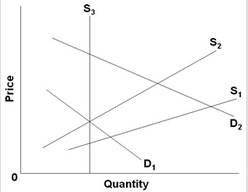Which of the following is false?
a. A Nash equilibrium can be a dominant strategy
b. A Nash equilibrium maximizes a player's welfare, given the actions of its competitor, while a dominant strategy maximizes a player's welfare, regardless of the behavior of its competitor.
c. A Nash equilibrium is just another name for a dominant strategy.
d. A Nash equilibrium is a self-enforcing equilibrium.
c
You might also like to view...
The theory of efficient markets suggests that the steep decline the value of stocks traded on the NASDAQ was due to
a. a speculative bubble. b. a response to new information about firms' expected future profitability.. c. a natural cycle in technology stock prices evidenced by charts of previous prices trends. d. moral hazard.
Use the figure below to answer the following question. The diagram concerns supply adjustments to an increase in demand (D1 to D2) in the immediate period, the short run, and the long run. In the immediate period, the increase in demand will
The diagram concerns supply adjustments to an increase in demand (D1 to D2) in the immediate period, the short run, and the long run. In the immediate period, the increase in demand will
A. increase equilibrium quantity but not equilibrium price. B. increase equilibrium price but not equilibrium quantity. C. increase both equilibrium price and quantity. D. have no effect on either equilibrium price or quantity.
Intelligent policymaking requires making trade offs, which means
A) accepting unethical but unavoidable compromises. B) giving up what is less valuable for what is more valuable. C) putting one's own interests ahead of the interests of others. D) sacrificing some people's welfare to other people's welfare. E) violating someone's rights.
A firm employs 100 workers at a wage rate of $10 per hour, and 50 units of capital at a rate of $21 per hour. The marginal product of labor is 3, and the marginal product of capital is 5. The firm
A) is producing its current output level at the minimum cost. B) could reduce the cost of producing its current output level by employing more capital and less labor. C) could reduce the cost of producing its current output level by employing more labor and less capital. D) could increase its output at no extra cost by employing more capital and less labor. E) Both B and D are true.